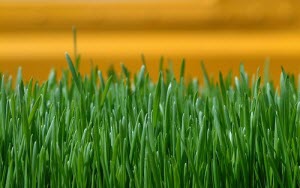In a nutshell, remember this key lawncare tip: Cut high and water infrequently.
Good One, Phil!
No, seriously. Set your mower as high as it will go (3 to 4 inches) and mow often. Then, water only when your grass shows signs of drought stress and then water deeply (1-2 inches of water).
Allow me to explain…
 The key to the lawn care game is competition. You want to make things favorable for the grass and unfavorable for the weeds so the grass will choke out the weeds. There is a fight going on in your lawn and you may not even realize it. It’s a fight for the sun. The sun is food for your lawn. Grass (and weeds) get strength and life from the sun. If your grass doesn’t shade out your weeds, then your weeds will shade out your grass. The shade causes weakness, disease and death.
The key to the lawn care game is competition. You want to make things favorable for the grass and unfavorable for the weeds so the grass will choke out the weeds. There is a fight going on in your lawn and you may not even realize it. It’s a fight for the sun. The sun is food for your lawn. Grass (and weeds) get strength and life from the sun. If your grass doesn’t shade out your weeds, then your weeds will shade out your grass. The shade causes weakness, disease and death.
If you cut your grass super short, then it will ultimately become a shade victim of the weeds. On the other hand, if you mow high, the shade of tall, dense grass will prevent essential light from reaching the weeds and will aid in the destruction of new baby weed seedlings.
But if I cut short, then I don’t have to mow as often
Wrong! Flase! Incorrect! SLAP! Your grass needs grass blades to do photosynthesis (convert sunshine into sugar) to feed the roots. When you whack the blades off, the grass has to race to make more blades to make sugar. It then grows incredibly fast. This fast growth uses up a lot of the grass’ stored sugar, and weakens the plant. It is now vulnerable to disease and pests! Tall grass is healthier and can use the extra sugar to make rhizomes (more grass plants) thus thickening the turf. Have you ever noticed that short grass in the summer is always riddled with dead brown patches?
If you have a severe weed problem, consider mowing even more often than you already do. The most sensitive spot for grass is near the root; the most sensitive spot for weeds is generally towards the top. So, when you mow (high), you are giving your grass a nice haircut, but cutting the heads off of the weeds.
Quit Watering Your Grass!
Ok, don’t quit all together; especially during this awesome summer drought we have been experiencing. But DO quit watering your lawn so much! Too much of a good thing can be a bad thing. Kind of like eating cake. We have talked about this before; over-watering your lawn actually causes the roots to shrink. When you water more infrequently, the roots of your grass will naturally grow longer and dig deeper. So, when the top of the soil does dry out, the roots for your grass are still plenty long enough to sing their chompers into the deeper, wet soil – deeper than most of the roots will be able to reach. See what we are doing here – giving our grass some tough love to grow up strong and beautiful, while weeding out the weeds. Oh, now I get that saying!
So how often do I water my Indianapolis lawn?
There are a couple of ways to tell. When your lawn gets thirsty, the grass blades will begin to curl before they ever turn brown. This is a good time to water. Place a cup in your lawn while you water so you can easily measure an inch or 2. (Or it comes out to about 1 and 2 hours of watering). Otherwise, try sticking a shovel about 6 inches into the soil and pushing it back just a little bit to see if there is moisture. If there is, then let it be. If it’s completely dry, then go ahead and water. Just remember, sometimes less really is more.
Your Soil is a Sponge
Take 2 sponges. One is completely dry – so dry that it’s hardened up. The other sponge is damp. Now poor a little bit of water on each sponge. The damp one will soak up every drop, while the water will run off of the dry sponge. Water has an odd attraction to itself. It would much rather stick to itself than run throughout the soil. Also, each time you water your lawn, you wash away nutrients. A less-watered lawn retains more nutrients.
Give it a shot for yourself. Follow these tips and let me know if it doesn’t just turn your lawn into a greener, healthier one!

Leave a Reply